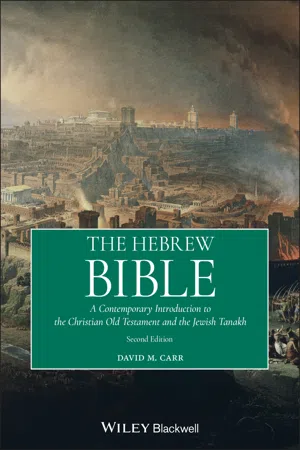
The Hebrew Bible
A Contemporary Introduction to the Christian Old Testament and the Jewish Tanakh
- English
- ePUB (mobile friendly)
- Available on iOS & Android
The Hebrew Bible
A Contemporary Introduction to the Christian Old Testament and the Jewish Tanakh
About this book
Discover the historical and social context of one of the most influential works ever written with this authoritative new resource
The newly revised second edition of The Hebrew Bible: A Contemporary Introduction to the Christian Old Testament and Jewish Tanakh delivers a brief and up-to-date introduction to the Hebrew Bible/Old Testament in the broader context of world history. Its treatment of the formation of the Bible amidst different historical periods allows readers to understand the biblical texts in context. It also introduces readers to scholarly methods used to explore the formation of the Hebrew Bible and its later interpretation by Jews and Christians.
Written by a leading scholar in the field, this new edition incorporates the most recent research on the archaeology and history of early Israel, the formation of the Pentateuch, and the development of the historical and poetic books. Students will benefit from the inclusion of study questions in each chapter, focus texts from the Bible that illustrate major points, timelines, illustrations, photographs and a glossary to help them retain knowledge.
The book also includes:
- A deepened and up-to-date focus on recent methods of biblical study, including trauma studies, African American, womanist, and ecocritical approaches to the Bible
- An orientation to multiple bibles, translations and digital resources for study of the Bible
- An exploration of the emergence of ancient Israel, its first oral traditions and its earliest writings
- Discussions of how major features of the Bible reflect communal experiences of trauma and resilience as Israel survived under successive empires of the Ancient Near East.
- Fuller treatment of the final formation of biblical books in early Judaism, including coverage of diverse early Jewish texts (e.g. Ben Sira, Enoch, Judith) that were revered as scripture before there were more clearly defined Jewish and Christian Bibles
Designed for students of seminary courses and undergraduate students taking an introduction to the Hebrew Bible/Old Testament, this second edition of The Hebrew Bible also will interest general readers with interest in the formation of the Bible.
Frequently asked questions
- Essential is ideal for learners and professionals who enjoy exploring a wide range of subjects. Access the Essential Library with 800,000+ trusted titles and best-sellers across business, personal growth, and the humanities. Includes unlimited reading time and Standard Read Aloud voice.
- Complete: Perfect for advanced learners and researchers needing full, unrestricted access. Unlock 1.4M+ books across hundreds of subjects, including academic and specialized titles. The Complete Plan also includes advanced features like Premium Read Aloud and Research Assistant.
Please note we cannot support devices running on iOS 13 and Android 7 or earlier. Learn more about using the app.
Information
1
Studying the Bible in its Ancient Context(s)
- Chapter Overview
- Academic Study of the Bible
- The Geography and Major Characters of the Biblical Drama
- Major Periods in the Biblical Drama
- Multiple Contexts, Multiple Methods
- Conclusion
- Chapter One Review
- Resources for Further Study
- Appendix: Israel’s History and Empires
CHAPTER OVERVIEW

EXERCISE
Academic Study of the Bible
Overview: Order of Main Discussions of Biblical Books
| Steps in the Bible’s own story | This textbook’s discussion of biblical texts and traditions in the order they were created |
| Creation, flood, and other materials about the origins of the world (Genesis 1–11) Stories of Israel’s patriarchs and matriarchs (e.g. Abraham and Sarah, Jacob, Joseph; Genesis 12–50) The growth of the people of Israel and their exodus from Egypt (Exodus 1–15) 40 years in the wilderness, gift of law at Sinai (Exodus 16–40; Leviticus, Numbers, Deuteronomy) Israel’s conquest of Canaan (Joshua) Tribal life under various leaders (Judges) The establishment of Saul and then David’s monarchy (1–2 Samuel) The kings of Jerusalem and Israel (1–2 Kings 17 also 1 Chronicles 10–2 Chronicles 2... |
Table of contents
- Cover
- Table of Contents
- Title Page
- Copyright Page
- Figures
- Maps
- Main Discussions/Outlines of Biblical Books
- Preface to the First Edition
- Acknowledgments
- Abbreviations
- Overview of the Historical Period
- Timeline
- Prologue
- 1 Studying the Bible in its Ancient Context(s)
- 2 The Emergence of Ancient Israel and its First Oral Traditions
- 3 Beginnings of the Monarchy and Royal and Zion Texts
- 4 Interlude
- 5 Narrative and Prophecy Amidst the Rise and Fall of The Northern Kingdom
- 6 Micah, Isaiah, and the Southern Prophetic Encounter with Assyria
- 7 Torah and History in the Wake of the Assyrian Empire
- 8 Prophecy in the Transition from Assyrian to Babylonian Domination
- 9 Laments, History, and Prophecies after the Destruction of Jerusalem
- 10 Torah and Trauma
- 11 The Torah, the Psalms, and the Persian‐Sponsored Rebuilding of Judah
- 12 Other Texts Formed in the Crucible of Post‐Exilic Rebuilding
- 13 Hellenistic Empires and the Formation of Multiple Scriptures
- Glossary
- Index
- End User License Agreement